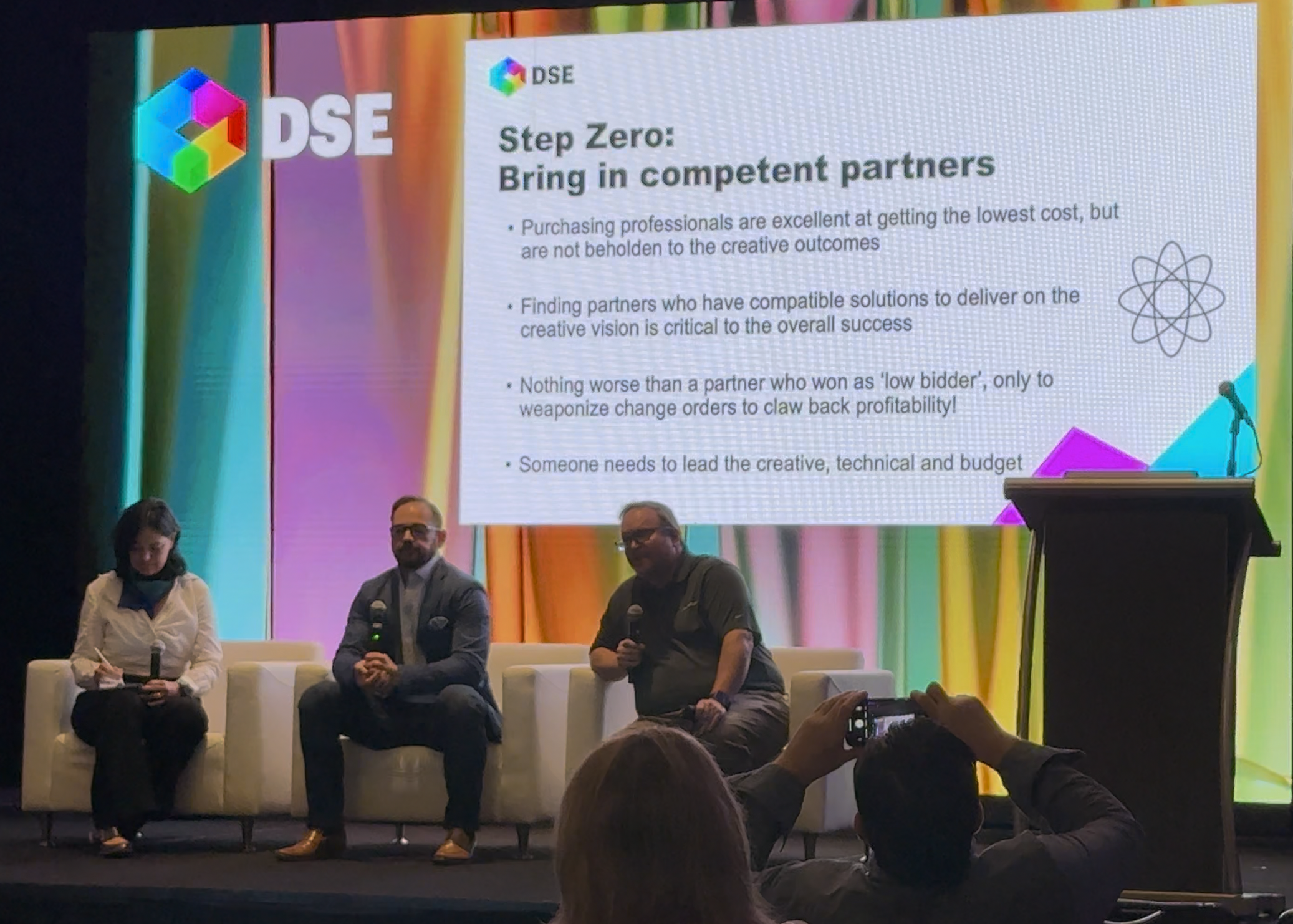**CFIRE Field Notes InfoComm + DSE 2025, Experience Meets Infrastructure**
Across InfoComm Orlando and DSE San Diego, one theme cut through every conversation:
large-scale digital is no longer about screens, it’s about integrated systems where content, tech, and operations function as one.
Read below the signals that matter most.
01. The 3-Legged Stool Is the New Baseline
SNA Display’s Paul England summarized the maturing reality of experiential work:
“Competent partners. Clear budget.
Plan the work, work the plan.
Communicate ×3. Commit to success.”
His message:
experiential only succeeds when Content, AV–IT/CMS, and Operations are aligned and accountable.
This is the gap & experience-led role CFIRE is most often brought in to solve.
02. DSE Leaders Roundtable: Experience Is Now Cross-Disciplinary
Moderated by Jackie Walker (Publicis Sapient, my alma mater as a Digital Strategy and Analytics Director), the DSE Leaders Roundtable brought together leaders from retail, architecture, aviation, integration, and multimedia experience design.
Panelists emphasized that immersive experiences must now bring together architecture, brand, operations, and engineering, and that the hand-off model is no longer viable.
Key moments:
Thibaut Duverneix (Gentilhomme): large-scale work like JFK T1 shows how artistic vision and system design must be engineered together.
Ryan Taylor (Delta): digital touchpoints should guide the passenger journey, not just be decoration along it.
Justin Rankin (Gensler): digital is now part of the architectural narrative, not an afterthought.
The point:
Experience is now multi-disciplinary (customer journey, architecture, design, engineering, IT, operations)
03. Airports: Leading the Way in System-Level Thinking
The Tampa International Airport (AKA TPA) session (Criswell, Nelson, Wycoff; moderated by Solberg) underscored the airport sector’s role as the test-bed for next-gen experiential systems:
Turning the entire airport into a dynamic digital canvas
Blending real-time information, ambience, retail networks, DOOH into a single platform
Designing digital as part of the architecture + utility + storytelling, not just flight info and content loops
Airports are now the R&D labs for future mixed-use districts and city-scale environments.
04. Retail Keynote: Stores Must Move at the Speed of Culture
Ariel Haroush’s keynote framed today’s retail challenge:
Consumers expect physical stores to feel as dynamic as their digital feeds
In-store retail media is becoming its own channel
Immersive, data-driven environments are now the base expectation
Retail is shifting into a living content platform, not a static environment.
05. GenAI at DSE: Content Pipelines Are About to Change
Google Cloud’s Katie Nguyen offered one of the most practical viewpoints on AI:
Faster concepting and versioning
Higher quality adaptive assets
Real-time, context-aware variations
This isn’t “AI spectacle” it’s the potential to rebuild the experiential content workflow.
For CFIRE, the integration of AI pre-visualization, media production, content program development, and support directly accelerates scalable, multi-layer content ecosystems.
InfoComm: AI Acceleration, Content Strategy, and the Next Wave of Experience Systems
InfoComm’s themes this year pointed squarely at where large-scale experiential is going:
AI is now a production pipeline, not a novelty.
GenAI sessions showed faster concepting, adaptive variations, and real-time content responsiveness becoming standard.The Experience Economy is redefining physical spaces.
Environments must move at the speed of digital culture: dynamic, data-driven, and continuously refreshed.The content–integrator gap is finally being addressed.
A clear message surfaced: content strategy, system design, and day-2 operations must function as one continuous workflow.Industry convergence is accelerating.
AV, cloud, broadcast, and real-time media are merging into an interoperable ecosystem — the foundation for future immersive environments.
The takeaway: experiential is shifting from hardware installations to intelligent, content-aware systems, exactly where CFIRE operates.
People & Perspectives
A few standout connections from this season: the kinds of conversations that remind you where the field is really heading:
Thibaut Duverneix (Gentilhomme) - now leading the immersive art program for JFK T1. Always sharp on how artistic vision, architecture, and system design come together at scale.
Jeremy Kolieb - creator of the original Westfield Dome (Obscura × SF Ballet, ~2013). Still one of the clearest examples of earliest ROI. focused experiential thinking done right (led to increased foot traffic, tenant occupancy and sales using spherical spectacle and sponsorships before anyone else even did this)
Nathan Houchin (Downstream) - continues to champion the architecture-first design and business development approach that’s now essential for integrated environments.
Pat Green and Mike Sabia (Client Solutions Group) - great to reconnect over the season (CODAworx Summit among others). Strong alignment as we look toward larger platform-level and AI-driven collaborations.
In short: the right people are thinking bigger, designing smarter, and pushing the discipline in exactly the direction CFIRE is already operating.
The Bottom Line
Both shows pointed to the same conclusion:
Experience = Art + Systems + Operations, all built together from day one.
Not hand-offs.
Not isolated screens.
A platform.
This is the model CFIRE has championed from the start, and 2025 is the year the broader industry caught up!
